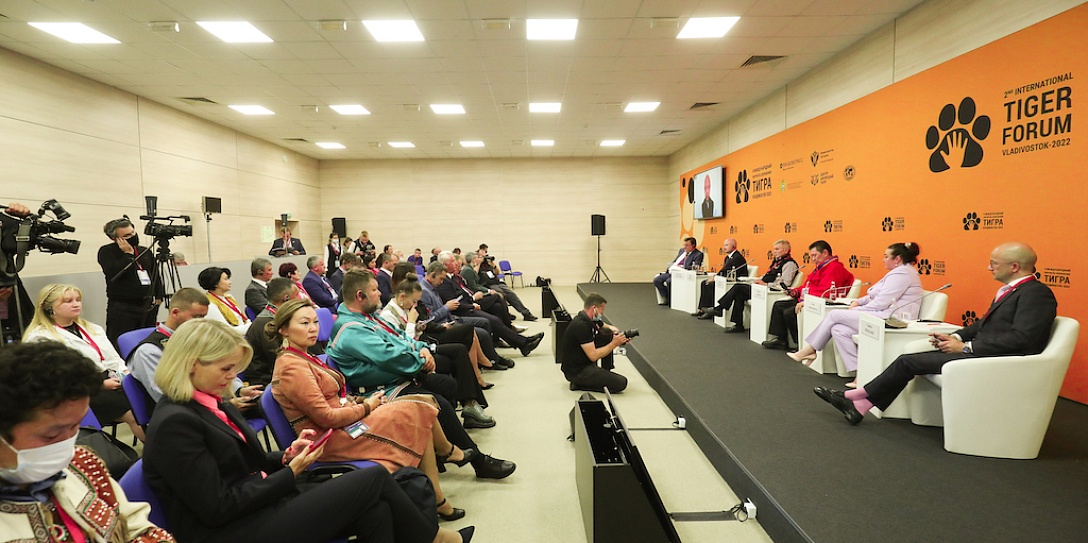Key conclusions
Measures taken to date are insufficient, and efforts are needed to reach a new level
“The things we discussed 12 years ago in St. Petersburg need to be ramped up to a new level. Back then, we had five top-level representatives from various nations in attendance. Now we need to talk about forging a global alliance. Global leaders need to take on this challenge. It must be reflected in the policies pursued by countries. Funding needs to be provided by international financial institutions. Only through such efforts will we be able to protect the tiger in its natural habitat over the coming 5–10 years,” Keshav Varma, Founding Director, Program Director, Global Tiger Initiative (GTI).
“We need to combine best practices and somehow systemize this constructive experience. It’s not right to have each country reinventing the wheel,” Konstantin Chuychenko, Minister of Justice of the Russian Federation.
The tiger is part of the ecosystem
“The tiger not only indicates a sustainable environment, it also, in a way, indicates steady economic growth. We have seen how national parks (in India, for example) are important sources of development, jobs, and so on. All of this is not only linked to a sustainable environment, but also to economic growth. So, I would advise all prime ministers to declare the tiger as the animal of the entire Asian region,” Keshav Varma, Founding Director, Program Director, Global Tiger Initiative (GTI).
“We inevitably run into the issue of climate change. Tigers somehow are at the intersection of these issues. We have seen that every initiative needs to be linked together. Conserving biodiversity is directly related to climate change – the ice is melting, and their habitat is changing... There are natural disasters which we cannot control or prevent, but there are things which are linked to human activity. There’s agriculture, for example – the use of land for agricultural purposes,” Rajesh Gopal, Secretary General, Global Tiger Forum.
“Preserving biodiversity has long been a central part of European companies’ DNA. [Businesses – ed.] need to build relations on all sides – including with the public, the environment, and others in the ecosystem. European companies have many years of experience doing this sort of thing in their niche,” Tadzio Schilling, Chief Executive Officer, Association of European Businesses (АЕВ).
“When we talk about climate change, it’s crucial to show society at a global level that these investments will benefit all of humanity. If we allocate money to protect the forests where tigers live, this will also help preserve natural resources as a whole,” Rajesh Gopal, Secretary General, Global Tiger Forum.
PROBLEMS
Funding: a global deficit and a lack of interest locally
“We lose so many tigers due to poaching. And in terms of resources, again, the situation has worsened. Back in 2010, there was an annual deficit of USD 66 million. However, today that figure is almost USD 240 million. This money is just to protect these animals,” Keshav Varma, Founding Director, Program Director, Global Tiger Initiative (GTI).
“Administrative bodies play a very important role, but without allocating financial support, nothing will be possible. We need to talk about an inclusive agenda. We must provide certain services. We need to accept sponsorship. We must oversee the local population and get them involved. All players in this context can make a contribution,” Rajesh Gopal, Secretary General, Global Tiger Forum.
“Institutions which manage specially protected natural areas are publicly funded federal organizations. There is good reason for this. As set out in their articles of association, their direct areas of activity cannot be geared towards making money. We realize this, which is why they are publicly funded. The state must fund them – they are simply obliged to do this. Unfortunately, however, we do not quite see eye to eye with the Ministry of Finance, to put it mildly,” Irina Makanova, Director of the Department of State Policy and Regulation in the Development of Specially Protected Natural Areas, Ministry of Natural Resources and Environment of the Russian Federation.
“This festival – Tiger Day – was not our idea, and not initiated by us. We have been around for nine years, but the festival is 20 years old... It was the idea of a scientist by the name of Troinin. It was then held by the government of Vladivostok and other bodies for 10 years, and we gave this festival a certain vitality. There is criticism that we monopolized the event. And probably that’s right, but we monopolized it because nobody else involved in the process agreed to help fund it,” Konstantin Chuychenko, Minister of Justice of the Russian Federation.
A conflict between tradition and education
“The demand for tiger parts is down to some of the traditions of Chinese medicine. It is believed that they contain medicinal properties, but there is no scientific proof of this. Efforts have been made to convince people, but the country – the state – does nothing about it. This is also an issue in other countries, such as Vietnam, Laos, Cambodia, and even Myanmar… There is a demand there – it is very sad. If the demand exists, illegal trade and poaching will continue. We must close down the tiger farms and adopt some strategies... We need to call upon China and other countries to work together on this,” Keshav Varma, Founding Director, Program Director, Global Tiger Initiative (GTI).
“Any tradition or policy – including those shaped by traditions – can be changed. However, in order to do this, education needs to play a key role,” Irina Makanova, Director of the Department of State Policy and Regulation in the Development of Specially Protected Natural Areas, Ministry of Natural Resources and Environment of the Russian Federation.
“[In Russia – ed.] tiger conservation has been successful in part due to the attitude of indigenous peoples. National parks and nature reserves are being created, and for their part, indigenous peoples are willing to fully participate in these processes... One of the main aims, as we see it, is to ensure we are not excluded from these processes. The traditional environment of the place where we live needs to stay with us as efforts are made to protect the tiger and foster a new economy based around tourism,” Grigory Ledkov, Member of the Committee on Federal Structure, Regional Policy, Local Government and Northern Affairs of the Federation Council of the Federal Assembly of the Russian Federation; President, Association of Indigenous Peoples of the North, Siberia and the Far East.
SOLUTIONS
Implementing global solutions, including a resolute funding strategy and participation on the ground
“The St. Petersburg Declaration really had a big impact. It encompasses involvement by various countries, and increasing support. This includes providing budgets for these programmes, and support from international financial organizations. Back then, 2.017 billion was earmarked to protect the tiger... Unfortunately, I have to say that decisions taken at the policy level are of course not enough. Without specific efforts on the ground, nothing will be accomplished,” Keshav Varma, Founding Director, Program Director, Global Tiger Initiative (GTI).
“All countries should commit to fully funding these programmes. These are not just programmes and plans – we also need people at the coalface, so to speak. These include inspectors and rangers to patrol the forests. A resolute strategy needs to be in place so that we don’t let things worsen in Thailand, Malaysia, and Indonesia,” Keshav Varma, Founding Director, Program Director, Global Tiger Initiative (GTI).
Taking tangible action, including working with the local population and boosting ecotourism
“The local population is an important stakeholder – they know about the forests near where they live. It’s also important to involve non-profit organizations, local bodies, and all interested parties,” Rajesh Gopal, Secretary General, Global Tiger Forum.
“In part, we need to convey the knowledge and traditional beliefs of indigenous peoples in order to promote the approach we take to animals, principles of conservation, the way we view animals, and the way we treat the natural environment. This may involve education, or form part of efforts to boost ecotourism – an area which is currently developing,” Grigory Ledkov, Member of the Committee on Federal Structure, Regional Policy, Local Government and Northern Affairs of the Federation Council of the Federal Assembly of the Russian Federation; President, Association of Indigenous Peoples of the North, Siberia and the Far East.
“If people have decent jobs and salaries, then they won’t waste time on the dangerous enterprise of trying to capture endangered animals. One objective of our organization, our partners, and the government is to enact socioeconomic change... The key objective is to ensure that there are enough forests for both people and tigers... Another important objective we have is to promote the sustainable use of natural resources. We support legitimate hunters – those who deal in non-timber forest products,” Sergey Aramilev, General Director, Amur Tiger Centre Autonomous Non-Profit Organization.
“National parks should play a role in building settlements. They should be centres of economic activity. In order to achieve this, they need help. For one thing, they won’t do this themselves, and for another, they are not business-inclined – their strengths lie elsewhere. We want to establish certain industries there – small ones which will enable people to not just survive, but earn money, and which will be a supporting bedrock for the indigenous population,” Konstantin Chuychenko, Minister of Justice of the Russian Federation.
A number of results are already in evidence
“In 2021–2022, our institutions organized more than 1,000 educational events in the tiger’s natural habitat which focused on environmental matters. According to preliminary estimates, we have already reached more than 70,000 people, of whom a good half are children. These are the people we can invest in, in the form of training and education,” Irina Makanova, Director of the Department of State Policy and Regulation in the Development of Specially Protected Natural Areas, Ministry of Natural Resources and Environment of the Russian Federation.
“The institution of Tiger Day is a remarkable and fantastic example of an event which, among other things, promotes this rare animal to the general public. This year, Krasnodar Territory instituted Persian Leopard Day, and there is a huge desire to do similar in the Republic of Sakha (Yakutia), where the focus is more on helping polar bears – another rare animal. This is an example of how effective it can be to have a day with an emotional, cultural, and scientific focus which is dedicated to a rare animal,” Irina Makanova, Director of the Department of State Policy and Regulation in the Development of Specially Protected Natural Areas, Ministry of Natural Resources and Environment of the Russian Federation.
“Ecotourism does not have to be developed within the national parks or nature reserves themselves, but a person can build it up in an area where business is growing,” Sergey Aramilev, General Director, Amur Tiger Centre Autonomous Non-Profit Organization.
“Since 2014, when we intensified everything and got some tigers, we have received international interest... Over the past six years we have welcomed tourists from 26 countries [on our animal photography expeditions – ed.],” Alexander Batalov, Director, Forest Hunting Farm Durminskoe.
“In 2020, after the lifting of COVID-related restrictions, people primarily took their holidays in the country. Since 2020, visitor numbers at specially protected natural areas have grown at an exponential rate. Before then, it was zero,” Irina Makanova, Director of the Department of State Policy and Regulation in the Development of Specially Protected Natural Areas, Ministry of Natural Resources and Environment of the Russian Federation.






